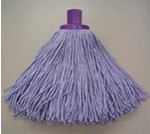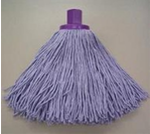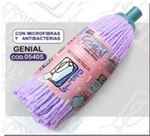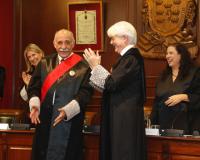
1. Hechos.
La compañía Mery y Celim, S.A. es titular de sendas marcas figurativas, española y de la UE, que cubren la siguiente representación:

Esa misma representación está cubierta por el diseño industrial español titularidad de la compañía Robest, S.L.
Ambas entidades iniciaron una acción de infracción de derechos de marca y diseño y de competencia desleal contra la entidad Betis Textil, S.A. que fabrica y comercializa una fregona lila –bajo el denominativo “GENIAL COLOR”- con el siguiente diseño:

La acción fue íntegramente desestimada en primera instancia y en apelación. Ambos pronunciamientos han sido confirmados por el TS en su sentencia.
2. Pronunciamientos.
El TS analiza, en primer lugar, la infracción marcaria denunciada y a este respecto, señala que en la comparación entre los signos en pugna, lo primero que debe tomarse en consideración es el signo cubierto por los registros de marca que sirven de base a la acción que, en este caso, es un signo figurativo bidimensional que consiste en la vista frontal de un mocho de fregona con una combinación de distintos tonos de lila.
A este respecto, el TS señala que “el ámbito de protección del derecho de exclusiva que atribuye el derecho de marca viene determinado por su inscripción registral, y, en concreto, por la clase de marca que se registra, (…)”.
En el caso que nos ocupa, ambas marcas fueron registradas como marcas figurativas y, por tanto, su objeto de protección no es la forma de un mocho de fregona de color lila que, en su caso, podría ser protegido mediante una marca tridimensional.
En cuanto al otro elemento de la comparación, el TS señala que lo que puede infringir el derecho de exclusiva de la demandante no es el producto comercializado por la demandada, sino el signo que esta utiliza a título de marca que, en este caso, sería el envoltorio plástico que envuelve la fregona y que contiene elementos denominativos y gráficos.
Pues bien, al comparar ambos elementos el TS concluye que no existe similitud alguna entre el signo protegido por los registros de marca base de la acción y el distintivo mixto utilizado por la demandada para identificar sus productos y, por tanto, descarta cualquier riesgo de confusión.
Seguidamente, el TS hace referencia al diseño base de la acción y confirma tanto la fijación que las sentencias recurridas hicieron del usuario informado, como la comparación efectuada entre los diseños enfrentados, excluyendo cualquier infracción.
3. Comentario.
El análisis del riesgo de confusión entre dos marcas debe partir del signo efectivamente protegido, tal y como ha sido registrado, y del distintivo utilizado por el demandado para identificar su producto, no del producto en sí que no será percibido como marca.
(Fuente de la información: ANUARIO ELZABURU 2016, recopilatorio de comentarios de jurisprudencia europea en materia de Derecho de Propiedad Industrial e Intelectual que realiza Elzaburu).
ENGLISH VERSION
Scope of protection of figurative trademarks versus three-dimensional trademarks. Judgment of the Spanish Supreme Court of 25 February 2016
1. Background.
Mery y Celim, S.A. is the holder of two figurative trademarks (Spanish and EU) covering the following graphic representation:

That same graphic representation is covered by the Spanish industrial design held by Robest, S.L.
Both companies brought proceedings for trademark and design infringement, as well as unfair competition, against Betis Textil, S.A., which manufactures and markets a lilac mop head under the name “GENIAL COLOR”. The design of that mop head is as follows:

The action was dismissed in its entirety at first instance and in appeal. Both findings have been upheld by the Supreme Court in its judgment.
2. Findings.
The Supreme Court first of all analyses the claim of trademark infringement, in respect of which it points out that the first aspect which must be taken into account when comparing the signs at issue is the sign covered by the trademark registrations on which the action is based. In the present case, this is a two-dimensional figurative mark consisting of a frontal view of a mop head in a combination of various tones of lilac.
In that regard, the Supreme Court indicates that “the scope of protection of the exclusivity conferred by trademark rights is determined by the registration of the trademark, and specifically by the type of trademark that is registered, (...)”.
In this case, both marks were registered as figurative trademarks, and so their protected subject matter is not the shape of a lilac mop head, which could be protected by means of a three-dimensional trademark.
As regards the other aspect of the comparison, the Supreme Court points out that what can infringe the plaintiffs’ exclusive rights is not the product marketed by the defendant but the sign which that party is using as a trademark. In this case, this would be the plastic wrapper for the mop head, which contains word and figurative components.
When comparing both elements, the Supreme Court concludes that there is no similarity whatsoever between the sign protected by the trademark registrations providing the basis for the action and the composite sign used by the defendant to identify its products. It therefore rules out all likelihood of confusion.
The Supreme Court then refers to the design on which the action is also based and confirms both the definition of the informed user given in the appealed judgments and the comparison carried out between the designs at issue, precluding any infringement.
3. Remarks.
The analysis of the likelihood of confusion between two trademarks must be based on the sign that is actually protected -as it has been registered- and the sign used by the defendant to identify its product, not the product per se, which will not be perceived as a trademark.
ElDerecho.com no comparte necesariamente ni se responsabiliza de las opiniones expresadas por los autores o colaboradores de esta publicación








